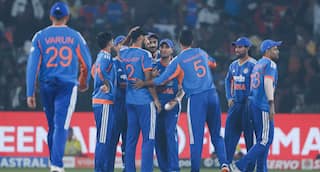There Will Be Variability In Rainfall Due To Climate Change, Expert Says As IMD Predicts Normal Monsoon For India
There will be lots of variability in rainfall during the southwest monsoon season due to climate change, which is making weather patterns unpredictable, according to an expert.

The Indian Meteorological Department (IMD) announced on Tuesday, April 12, 2023 that the southwest monsoon seasonal rainfall in India is likely to be normal. The rainfall will probably be 96 per cent of the Long Average Period of the seasonal rainfall over India, which is 87 centimetres for the 50-year-period from 1971 to 2020.
The southwest monsoon season in India is from June to September. When the rainfall range is 96 to 104 per cent of the LPA, it is considered to be normal, according to the IMD.
ALSO READ | India To See Normal Rainfall In Monsoon, El Nino Impact To Be Felt In Second Half: IMD
Lots of variability in rainfall during southwest monsoon season
However, there will be lots of variability in rainfall during the southwest monsoon season due to climate change, which is making weather patterns unpredictable, according to an expert.
“It is a sign of relief that the monsoon is going to be normal to the tune of 96% but this is an average rainfall pattern we have witnessed so far for the entire India. However, the problem is that because of climate change there will be lots of variability in rainfall during the season. This is something that is making weather patterns unpredictable,” said Dr Anjal Prakash, Research Director, Bharti Institute of Public Policy, Indian School of Business and IPCC Author.
Variability in rain is devastating to farmers
Dr Prakash also explained that even though the average rainfall remains the same, variability within the season may sometimes be devastating for farmers. This is because variable rainfall may create situations where farmers do not get enough water when they need it or get too much water when not needed. This is one of the ways in which climate change is affecting farmers.
“Recent examples of this are the hailstorm in Telangana, while Punjab saw crop damage due to early heatwave, followed by unseasonal rains. Such incidents tell us that even though average rainfall remains the same, it may not be the correct information to understand that variability of rainfall even exists. We have to take this into account and get into district or sub-district level forecasting to understand what is going to happen and how do we know what will be the rainfall pattern,” added Dr Prakash.
Climate change is driving the unseasonal rains
He said that he would “humbly refute” the IMD saying that heat waves or unseasonal rains are not because of climate change. This is because science has clearly proved the fact that climate change is here, and that global warming is one of the signs of climate change.
“Science has very clearly proved this, especially the IPCC AR6 report has clearly established that climate change is here and now. So, even though the IMD may say heat waves or unseasonal rains are not because of climate change, I would humbly refute what they are saying. We have been witnessing how farmers have been suffering due to the changing
monsoon patterns, early heatwaves and unseasonal rains,” said Dr Prakash.
He also said that he is not sure what the IMD is saying is right because the effects of climate change are felt everyday.
India must face the fact that El Niño impacts monsoon rainfall patterns
According to Dr Prakash, India must face the fact that El Niño impacts monsoon rainfall patterns, instead of being in denial mode. Only 40 per cent of El Niño years have resulted in “normal” or “above normal” monsoon, while 60 per cent of El Niño years have resulted in “below normal” monsoon. Hence, there is a 60 per cent chance of monsoon in India being “below normal” this year due to El Niño, Dr Prakash explained.
What is El Niño?
When conditions in the Pacific Ocean are normal, trade winds blow west along the equator. Trade winds are steady winds which flow towards the equator from the north-east in the Northern Hemisphere or the south-east in the Southern Hemisphere, especially at sea. These winds take warm water towards Asia.
Cold water rises from the depths to replace the warm water. This process is called upwelling. However, there are two conditions which break these normal conditions — El Niño and La Niña. El Niño is also known as the El Niño-Southern Oscillation (ENSO) cycle and can impact weather patterns globally.
Both El Niño and La Niña typically last nine to 12 months, and can occur every two to seven years, on average.
El Niño is the phenomenon in which trade winds weaken, as a result of which warm water is pushed back east, toward the west coast of the Americas, where the Pacific Ocean is present.
How El Niño can impact India’s monsoon this year
Since warm water has been pushed back east due to El Niño, the monsoon in India is likely to be affected.
“Why do we take the smaller denomination rather than understanding the larger trend that shows that El Niño has an impact on monsoon rainfall patterns. This is the new normal. Instead of being in denial mode, we must face it. Only then we would be able to work towards adaptation and mitigation measures. These measures are of utmost importance at this point of time where we have been witnessing unprecedented incidents. In fact, by the time I say this there will be a new precedent,” said Dr Prakash.
He explained that new records are broken in a short span of six to seven months, which is something that needs to be acknowledged. He also said that the IMD, instead of being in denial, should acknowledge the fact there is variability of rainfall, which has impacted farmers and other climate-sensitive sectors.
“Instead of being in denial, I would say that the IMD should acknowledge the fact that there is variability of rainfall, which has had an impact on farmers and other climate sensitive sectors. We need to do something about it. That is where the answer lies in terms of finding solutions and coordinated action so that the last person is not affected by the whole problem,” said Dr Prakash.







































